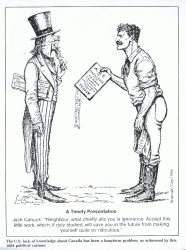Field Trip to Canada Without Leaving the Classroom
Introduction:
If your students are like our students in Maine, they view themselves as worldly – largely because of their exposure to other countries and cultures through food, possessions, study, relatives, and perhaps travel. With their worldly self-view they nonetheless have an incomplete concept of Canada as a culture, a country, as a place in the world.
Many students will tell you they “know” Canada. Students whose families vacation in Prince Edward Island know Canada as a flat, agricultural, English-speaking country; students whose relatives live in New Brunswick or whose families attend the Quebec Winter Carnival know Canada as a snowy and primarily French-speaking country.
So how do we broaden our students’ existing world view of Canada and encourage their curiosity to learn more during a Canada culture study unit? Inspired by a program created by Andrew Mullen, Associate Professor of Education at Westmont College, we developed Field Trip to Canada Without Leaving the Classroom as an introduction to a multi-week Canada unit.
Description of Our Experience:

Field Trip to Canada is a middle-school level hands-on introduction to Canada. It contains 20 exhibits which students visit to investigate objects and images of Canadian culture. Students examine Canadian art, books, political cartoons, maps, and other primary and secondary source materials. At each exhibit they are asked to solve problems, respond to questions, and write summary statements. The tasks are designed to strengthen social studies skills such as using primary and secondary sources to acquire information; analyzing information by categorizing, summarizing and making generalizations; identifying bias in visual material; and using appropriate mathematical skills to interpret social studies information such as maps.
To create the Field Trip to Canada, we collected food wrappers, tourism materials, money, stamps, children’s books, and other material from trips to Canada and from friends who live or visit there. Collecting the resources listed, and using the framework provided, you may be able to assemble 10-15 exhibits fairly easily in several weeks. Or, incorporate collecting materials for the exhibits into student work in the Canada Unit.
The current selection of exhibits covers many of the elements of culture study: language, celebrations, food, leisure, sports, literature, government, art. Over time we will continue to evolve the exhibits, and we will add some of the obvious omissions such as Music, and Technology/Inventions. You may even suggest exhibits!
Evaluation:
Pre-study Quiz / Post-study Quiz
Student reactions: How do our students react to the exhibit approach? Students liked choosing which exhibit to work with, and liked moving freely from exhibit to exhibit. They liked the specific tasks which they could accomplish with the presented materials in about 15 minutes, and they liked choosing to work alone or with partners.
Teacher reactions: Teachers were able to allow students to work alone, and periodically provide concentrated attention to students who encountered concepts or practices they had little familiarity with – such as working with political cartoons, or using math to calculate a geography question.
Learning: Do students learn anything by manipulating materials for 10-15 minutes? We gave students a Pre-Study Quiz before they undertook the Field Trip, and they took the same test as a Post-Study Quiz after working with all the exhibit materials. Comparing these quizzes shows an impressive increase in accuracy in their mental image of Canada. Here are some example responses:
Name one type of job done by people who live in the Canadian Prairies.
Anne (pre-quiz): “Hunt prairie dogs”
(post-quiz): “Farming”
Name something similar to Maine about land in British Columbia.
Desirae (pre-quiz): “Maple trees”
(post-quiz): “Rocky coast”
If someone said to you, “It must be cold in Canada because the temperature there is 20 degrees”,
you would say…
Anna (pre-quiz): “It is not cold to a Canadian – they’re used to it”
(post-quiz) “No, Canadians measure temperature in Celsius”

